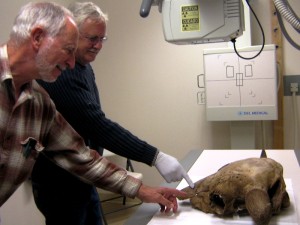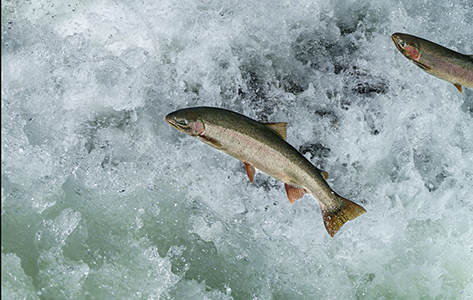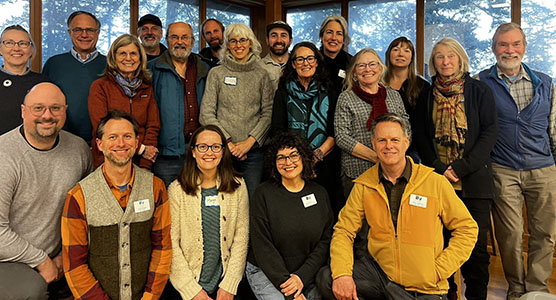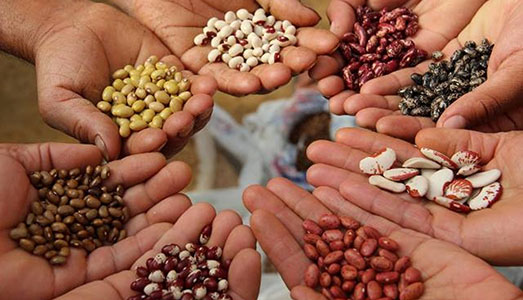
Bill Buchan, far left, and Steve Kenady point to evidence of a broken nose on the skull of the Bison Antiquus found in Ayer Pond.
Workmen commended for observation and careful excavation of prehistoric skull from Ayers Pond
Ever had a broken nose? Hurts like H-E-double toothpicks.
But in the case of Orcas’ own Bison Antiquus, evidence of a broken nose and later butchering may show that humans were hunting and butchering animals at an earlier time than what was previously thought.
In an article written by Archelogist Steve Kenady and others for the “Quaternary International,” the scientists describe “the details of the butchering evidence at Ayer Pond and a new date of 11,990 which is a little older than we thought,” Kenady said.
In Kenady et al.’s paper, they conclude: “Butchering by humans is the explanation that is most consistent with all of the physical evidence that is currently available for the male B. antiquus from Ayer Pond.”
Yesterday, June 7, Steven Kenady and Orcas Island Historical Society President Bill Buchan brought the bison antiquus skull to Dr. David Shinstrom’s clinic for an X-ray.
Following the publication of the study, Kenady has been advised by his peers to obtain “microscopic analysis of the butchering marks on the bones. They argue that stone tool fragments might be embedded in the bones and photomicrographs might strengthen the case for butchering.”
“New test results confirm the bison is Late Pleistocene in age.…The new date of 11,990 _ 25 14C BP reported here places the butchered Ayer Pond bison nearly 800 14C years older than the cluster of most reliably dated Clovis assemblages (Waters and Stafford, 2007), at a location where both hunters and bison could have ranged within a few tens of kilometers of the retreating Cordilleran ice sheet.”
Buchan said that the Orcas bison antiquus is the most complete, and most numerous example of its species found anywhere. Along with the skull, there are bone fragments from the ankle, spine, hindlegs and forelegs of the ancient bison.
Buchan and Kenady explain that the excellent condition of the skull is due to its not being “fully fossilized,” due to its preservation from ultraviolet light and its placement between the calcium-based layer of sea organisms and the acidic peat bog.”
The Burke Museum at the University of Washington and some private companies have expressed interest in borrowing the skull and making a casting that may then create models for study and display by other organizations.
The article in Quaternary International concludes, “We are most grateful to the local residents of Orcas Island for reporting their discoveries, granting permission for additional work on their land, and providing financial support. In particular, theworkmen who discovered the Ayer Pond bison are appreciated for keen observations and responsible handling of the finds. We thank Dan Watters, Bathan Shaner, and Dan Kimple for contacting the first author about their finds. Tony and Nancy Ayer are especially thanked for allowing us to study the Ayer Pond bison and for much assistance.
“The authors provided initial funding for fieldwork,initial dating of the Ayer Pond bison and identification of the tephra sample. The Orcas Island Historical Society and the Douglas College Scholarly Activities Fund provided additional funds for dating and Fieldwork.”
In the Quaternary International article’s abstract, Kenady reports, “Bone modifications on well-preserved Bison antiquus remains recently discovered during pond construction in the Pacific Northwest provide evidence suggestive of Late Pleistocene human activity.
“New test results confirm the bison is Late Pleistocene in age. A recent AMS radiocarbon date involving different pretreatment protocols places the event at 11,990 14C BP, slightly older than the first test results of 11,760 14C BP. These dates and observations were used to conclude that the bison was butchered by humans shortly after deglaciation.”
**If you are reading theOrcasonian for free, thank your fellow islanders. If you would like to support theOrcasonian CLICK HERE to set your modestly-priced, voluntary subscription. Otherwise, no worries; we’re happy to share with you.**







